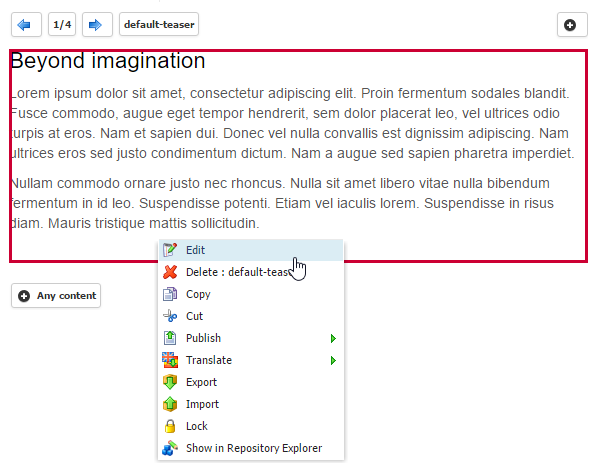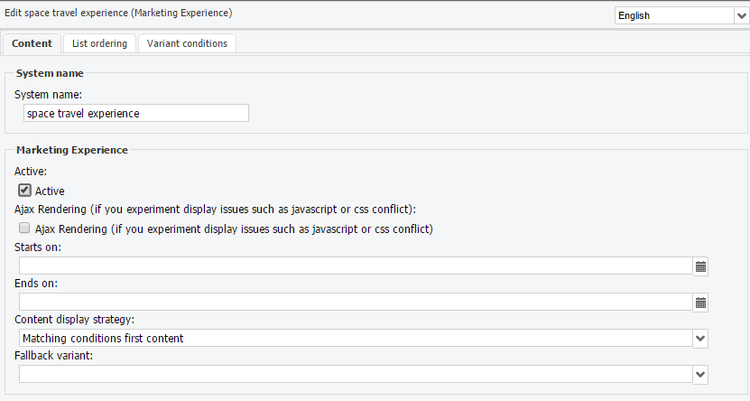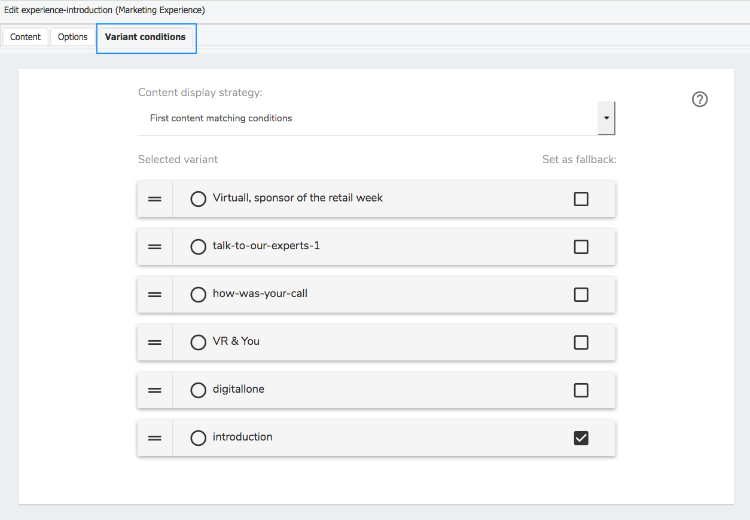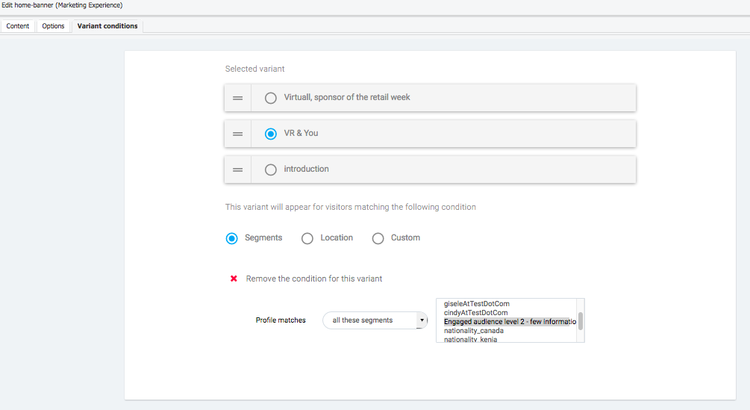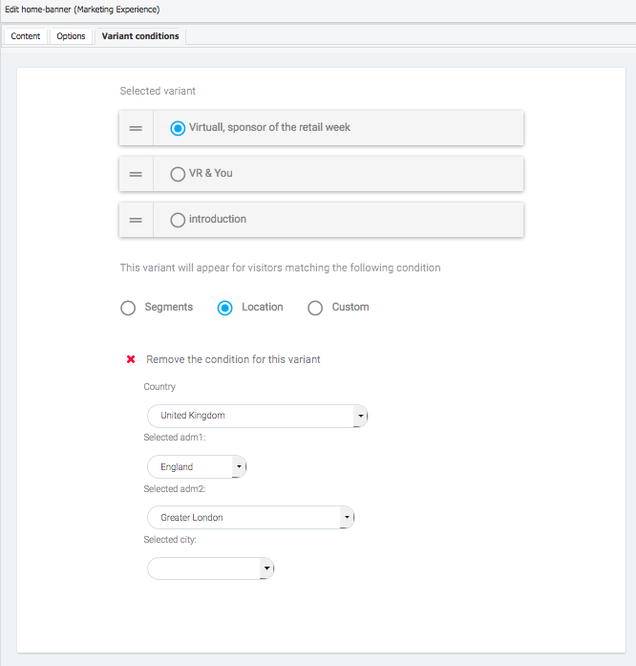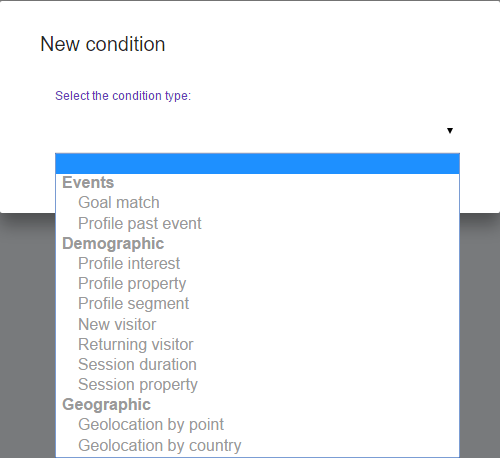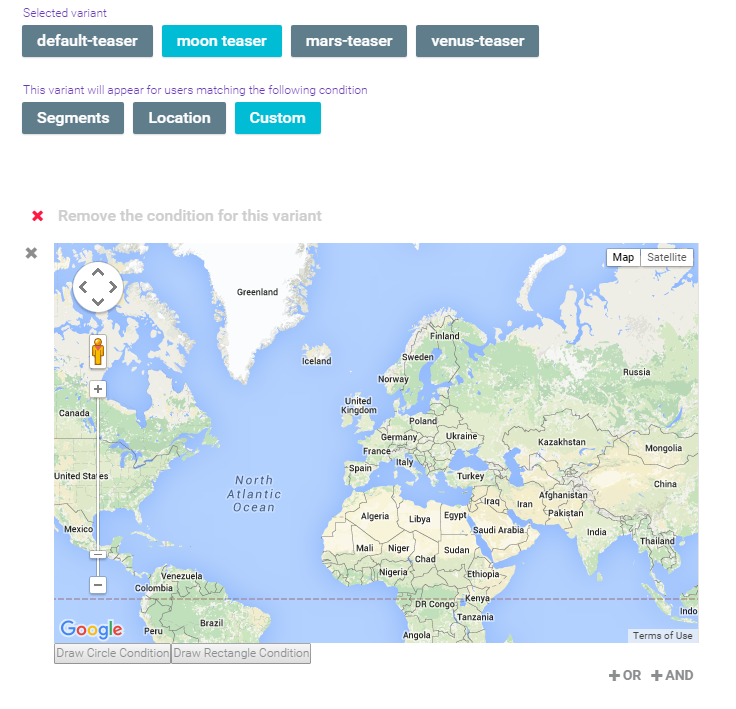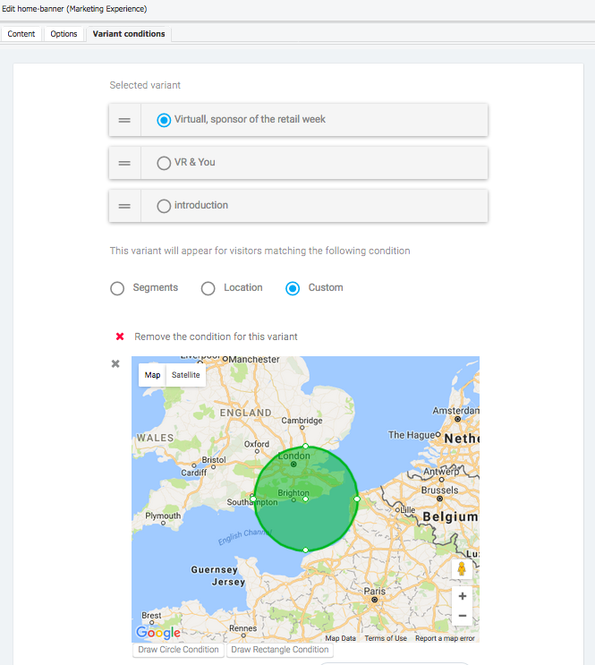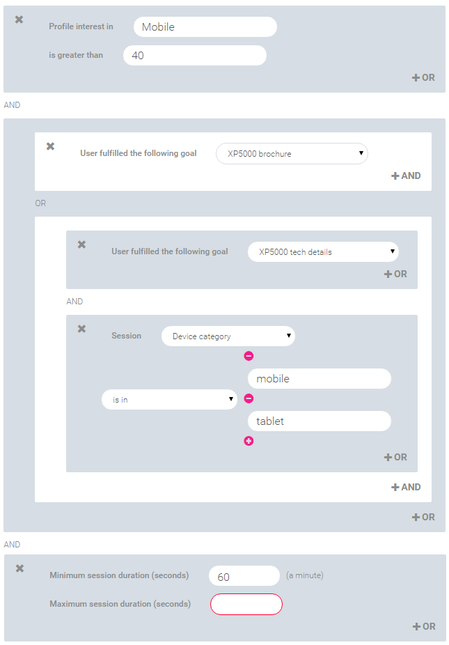Creating personalizations
Personalization is the ultimate online marketing feature that allows marketers to tailor the content displayed to the visitors in order to improve their customer experience by providing more accurate content, by anticipating their needs, by simplifying their digital life. Personalization is the art of showing the right content to the right person at the right moment.
1. Personalization definition
Personalization is the fact to deliver a specific content to a particular visitor based on what you know about him.
2. How personalization works
Personalization works by selecting an area in a page and adding multiple content items called variants in that area. Each variant is associated with conditions.
When a user arrives on the page, Digital Experience Manager receives the contextual information about that visitor from the Context Server, evaluates if and what variants conditions are matched by this visitor and displays the most appropriate one.
3. Personalize a content
Personalization experiences are created directly in Digital Experience Manager, in-context.
To create a personalized experience
- Go into any page of site (powered by Digital Experience Manager).
- Right click on the content on which you want to create personalized experience
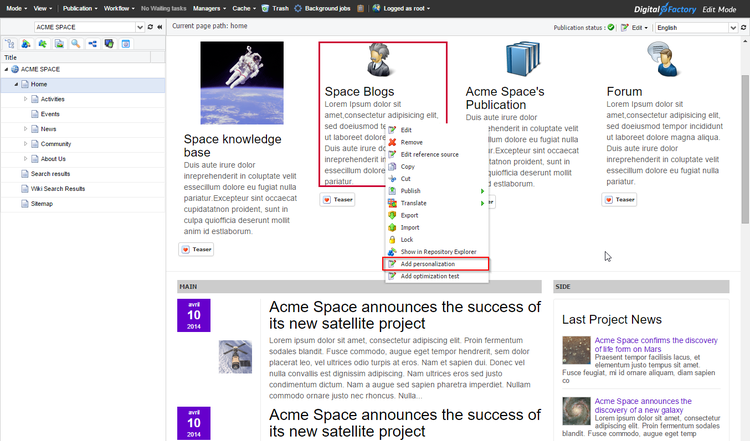
- Click on Add personalization
- A list is created that now surrounds the previously existing content
- A toolbar appeared
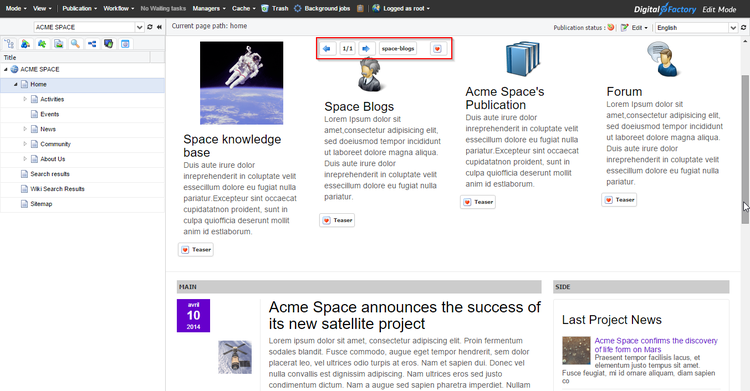
- Now you are ready to add other content items inside the personalized section.
- To add content you can
- Create a brand new content item by clicking on the plus icon in the toolbar

- Copy and paste existing content from your repository (the content is duplicated)

- Copy and paste a reference to existing content (an alias is created)

- Cut and paste existing content from your repository (the content is moved)

Each time a content is added to the Experience, the counter is updated
Thanks to the previous and next arrows, you can scroll the different content items. The name of the current item is displayed in a button.
To edit the properties of an item, scroll back or forward to make the content item appear, then right-click on edit, as you would do to edit any other content item in Digital Experience Manager Edit Mode.
Once youve created all your variants, you have to define, for each of them, the personalization rule that will define if the variant should be served to a visitor accessing this page or not.
Right-click in the toolbar and select Edit, or click on the button containing the current variant name:
In both cases, the following dialog will open. The first tab Content is selected by default.
|
Field |
Usage |
|
System name |
Name of the variant in the repository |
|
Active |
Checked by default. Uncheck to stop / pause the personalization process |
|
Ajax rendering |
If youre experiencing troubles to display some of the variants it may be because of a JavaScript or css conflict. That situation can happen in particular with content coming from an external service and embedded in your page. Check the box to try an alternate type of rendering and see if it solves the issue. |
|
Starts on |
The personalization will start on that date. If the field remains empty, the personalization will start immediately (as soon as the page is published) |
|
Ends on |
The personalization will stop automatically at that date. If the field remains empty, the personalization will never, until a manual action. |
|
Random content |
Digital Experience Manager will display randomly a variant between all the variants that match |
|
Matching conditions first content |
Digital Experience Manager will display the first variant WITH A CONDITION that matches in the order of the list. |
|
Fallback variant |
Defines which variant Digital Experience Manager should display if a visitor doesnt match any of the variants. If this field is empty, such a visitor will see nothing, the Experience will be empty. |
4. Personalize a page
Personalization can also be applied directly at the page level, again, in-context.
To personalize a page
- From DX, right click on the page that you want to personalize
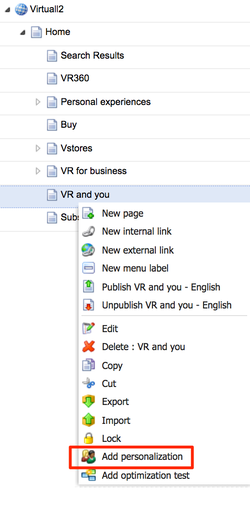
- Click on Add personalization
A toolbar appeared at the top right of the page

- Now you are ready to add a new page variant
- To add a new page variant you can click on the + Add button. It will copy the existing page as a new page variation
- To edit the properties of a page variation, use the arrows of the toolbar to go to your variant and then use this edit button:

- To edit the first page variant and the conditions of how they will display, you can use the DX existing edit button as follow (or use the right click => edit in the site tree panel).

- You can now edit the conditions that will define if a variant should be displayed or not, as you would do for any content.
5. Conditions
For each variant, marketers must define the rule that defines for which visitors it will be displayed. As for advanced search and segments, this activity is done using the condition builder that is explained in details in chapter Concepts. There are slightly more options to handle all the contextual information available during the session (the visit) and that is specific to this session.
5.1 Accesssing variant conditions
- Click on the third tab Variant conditions in the Edit dialog
5.2 Display strategies and ordering
- First content matching conditions: The first item of the list having a condition that matches the current profile and context will be displayed
- Random content: An item is randomly choosed out of all items in the list that match the conditions
- Sorted by score: Each condition will have to be associated to a score. The item with the highest score will be displayed.
Using "First content matching conditions" or "Sorted by score", you might want to reorder your variants. This can be done using drag n drop, as shown below:

5.3 Edit conditions for a variant
- Select the desired variant by clicking on its name
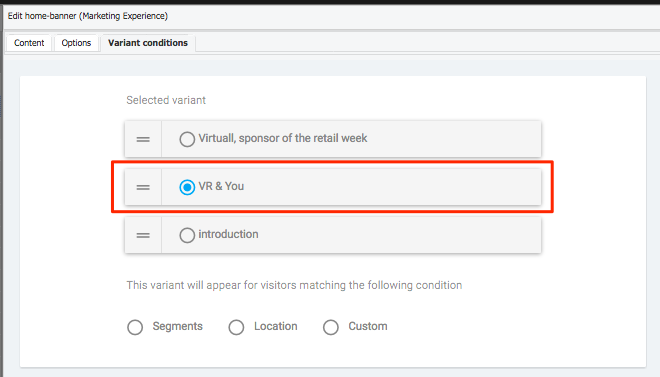
- Choose the type of rule:
- a. Segments allows to create fast personalization based only on segments. The list of segments is provided by the Context Server.
- b. Location allows to create fast personalization based only on the visitors current location (geolocation). This information is resolved by Marketing Factory when the user starts his or her session and is provided to Digital Experience Manager by the Context Server.
- c. Custom shows a complete condition builder, similar to what you have already seen previously in the profile advanced search or segments building. The only difference is that this condition builder provides also the context conditions that are not coming from the Context Server but are resolved on the fly for this particular visit.
- Define the conditions
- Save
- Publish
5.4 Conditions details
As explained, to make a marketers life easier and because those are the most common types of personalization rules, Marketing Factory allows to create a fully custom rule mixing all types of conditions and two more straightforward possibilities.
5.4.1 Segments
This option allows to define that a variant should be displayed to one or several segments, or to all segments except the ones selected.
5.4.2 Location
The Location condition allows to define if a visitor should see a variant based on where the current country connection is coming from (which is different from his profile address).
5.4.3 Custom
The custom entry allows to build a fully custom rule, based on all profile properties, behavior data (visitor history) and contextual information (session).
The custom rules are built based on the Condition Builder (see Chapter Concepts) starting by choosing a first condition
Then you can add other conditions with the AND or OR operators.
What differs from the standard Condition Builder used in segment and advanced search, is the presence of contextual information data to define conditions.
This contextual conditions available are:
- New visitor: the visitor is unknown to Marketing Factory.
- Returning visitor: the visitor already made one or several visits.
- Session duration.
- Session property: operating system, browser, IP address, etc.
- Geolocation by point: define a precise location from a central point
- Geolocation by country: just personalize on the country from which the visit is done
The geolocation by point allows to use a map (provided by Google maps) and to set an area around that point, square or circular by clicking on one of the bottom left buttons.
Handles around the circle / square allows to define a precise perimeter for your geo targeting.
Of course geolocation criteria can be combined with any other user property or session information.
As it is the case for segments, marketers can build very complex rules made of several conditions, nested or not, in order to target their visitors very precisely.
Lets use the following example
In the above example, the variant will be displayed to:
Visitors who are on the site since more than a minute, have an interest for mobile higher than 40 points in their profile and have already downloaded the XP5000 brochure (download goal)
OR
Visitors who are on the site since more than a minute, have an interest for mobile higher than 40 points in their profile, have already seen the XP 5000 technical details page (visit goal) and are currently browsing using a mobile or a tablet.
As previously explained, deciding to build very precise rules (which will target less people but with more accuracy) and evaluating if it is worth the effort is the marketers responsibility. Whatever the strategy, Marketing Factory is simply a tool that can support your efforts, from a simple personalization scenario down to a one-to-one conversation like this:
Obviously, that personalization rule will target only one person!


